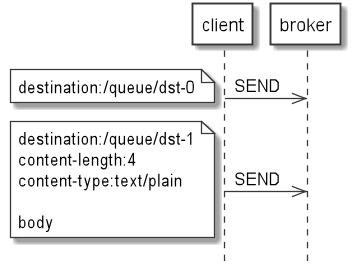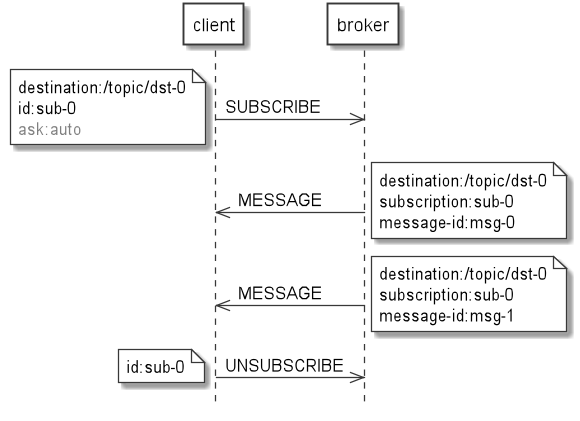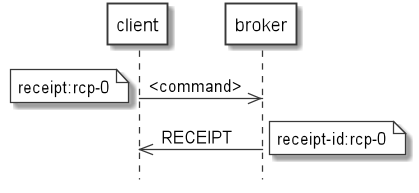WebSockets with Spring, part 3: STOMP over WebSocket
Introduction
The WebSocket protocol is designed to overcome the architecture limitations of HTTP-based solutions in simultaneous bi-directional communication. Most importantly, WebSocket has another communication model (simultaneous bi-directional messaging) than HTTP (request-response).
WebSocket works over TCP that allows transmitting of two-way streams of bytes. WebSocket provides thin functionality on top of TCP that allows transmitting binary and text messages providing necessary security constraints of the Web. But WebSocket does not specify the format of such messages.
WebSocket is intentionally designed to be as simple as possible. To avoid additional protocol complexity, clients and servers are intended to use subprotocols on top of WebSocket. STOPM is one such application subprotocol that can work over WebSocket to exchange messages between clients via intermediate servers (message brokers).
STOMP
Design
STOMP (Simple/Streaming Text Oriented Message Protocol) is an interoperable text-based protocol for messaging between clients via message brokers.
STOMP is a simple protocol because it implements only a small number of the most commonly used messaging operations of message brokers.
STOMP is a streaming protocol because it can work over any reliable bi-directional streaming network protocol (TCP, WebSocket, Telnet, etc.).
STOMP is a text protocol because clients and message brokers exchange text frames that contain a mandatory command, optional headers, and an optional body (the body is separated from headers by a blank line).
COMMAND
header1:value1
Header2:value2
body
STOMP is a messaging protocol because clients can produce messages (send messages to a broker destination) and consume them (subscribe to and receive messages from a broker destination).
STOMP is an interoperable protocol because it can work with multiple message brokers (ActiveMQ, RabbitMQ, HornetQ, OpenMQ, etc.) and clients written in many languages and platforms.
Сonnecting clients to a broker

Connecting
To connect to a broker, a client sends a CONNECT frame with two mandatory headers:
- accept-version - the versions of the STOMP protocol the client supports
- host - the name of a virtual host that the client wishes to connect to
To accent the connection, the broker sends to the client a CONNECTED frame with the mandatory header:
- version - the version of the STOMP protocol the session will be using
Disconnecting
A client can disconnect from a broker at any time by closing the socket, but there is no guarantee that the previously sent frames have been received by the broker. To disconnect properly, where the client is assured that all previous frames have been received by the broker, the client must:
- send a DISCONNECT frame with a receipt header
- receive a RECEIPT frame
- close the socket
Sending messages from clients to a broker

To send a message to a destination, a client sends a SEND frame with the mandatory header:
- destination - the destination to which the client wants to send
If the SEND frame has a body, it must include the content-length and content-type headers.
Subscribing clients to messages from a broker

Subscribing
To subscribe to a destination a client sends a SUBSCRIBE frame with two mandatory headers:
- destination - the destination to which the client wants to subscribe
- id - the unique identifier of the subscription
Messaging
To transmit messages from subscriptions to the client, the server sends a MESSAGE frame with three mandatory headers:
- destination - the destination the message was sent to
- subscription - the identifier of the subscription that is receiving the message
- message-id - the unique identifier for that message
Unsubscribing
To remove an existing subscription, the client sends an UNSUBSCRIBE frame with the mandatory header:
- id - the unique identifier of the subscription
Acknowledgment
To avoid lost or duplicated frames, if a client and a broker are parts of a distributed system, it is necessary to use frames acknowledgment.
Client messages acknowledgment

The SUBSCRIBE frame may contain the optional ack header that controls the message acknowledgment mode: auto (by default), client, client-individual.
When the acknowledgment mode is auto, then the client does not need to confirm the messages it receives. The broker will assume the client has received the message as soon as it sends it to the client.
When the acknowledgment mode is client, then the client must send the server confirmation for all previous messages: they acknowledge not only the specified message but also all messages sent to the subscription before this one.
When the acknowledgment mode is client-individual, then the client must send the server confirmation for the specified message only.
The client uses an ACK frame to confirm the consumption of a message from a subscription using the client or client-individual acknowledgment modes. The client uses a NACK frame to negate the consumption of a message from a subscription. The ACK and NAK frames must include the id header matching the ack header of the MESSAGE frame being acknowledged.
Broker commands acknowledgment

A broker sends a RECEIPT frame to a client once the broker has successfully processed a client frame that requests a receipt. The RECEIPT frame includes the receipt-id header matching the receipt header of the command being acknowledged.
Examples
Introduction
The Spring Framework provides support for STOMP over WebSocket clients and servers in the spring-websocket and spring-messaging modules.
Messages from and to STOMP clients can be handled by a message broker:
- a simple STOMP broker (which only supports a subset of STOMP commands) embedded into a Spring application
- an external STOMP broker connected to a Spring application via TCP
Messages from and to STOMP clients also can be handled by a Spring application:
- messages can be received and sent by annotated controllers
- messages can be sent by message templates
The following example implements STOMP over WebSocket messaging with SockJS fallback between a server and clients. The server and the clients work according to the following algorithm:
- the server sends a one-time message to the client
- the server sends periodic messages to the client
- the server receives messages from a client, logs them, and sends them back to the client
- the client sends aperiodic messages to the server
- the client receives messages from a server and logs them
The server is implemented as a Spring web application with Spring Web MVC framework to handle static web resources. One client is implemented as a JavaScript browser client and another client is implemented as a Java Spring console application.
Java Spring server
Configuration
The following Spring configuration enables STOMP support in the Java Spring server.
@Configuration
@EnableWebSocketMessageBroker
public class StompWebSocketConfig implements WebSocketMessageBrokerConfigurer {
@Override
public void registerStompEndpoints(StompEndpointRegistry registry) {
registry.addEndpoint("/websocket-sockjs-stomp").withSockJS();
}
@Override
public void configureMessageBroker(MessageBrokerRegistry registry) {
registry.enableSimpleBroker("/queue", "/topic");
registry.setApplicationDestinationPrefixes("/app");
}
}
Firstly, this configuration registers a STOMP over WebSocket endpoint with SockJS fallback.
Secondly, this configuration configures a STOMP message broker:
- the destinations with the /queue and /topic prefixes are handled by the embedded simple STOMP broker
- the destinations with the /app prefix are handled by the annotated controllers in the Spring application
For the embedded simple broker, destinations with the /topic and /queue prefixes do not have any special meaning. For external brokers, destinations with the /topic prefix often mean publish-subscribe messaging (one producer and many consumers), and destinations with the /queue prefix mean point-to-point messaging (one producer and one consumer).
Receiving and sending messages in annotated controllers
Messages from and to STOMP clients can be handled according to the Spring programming model: by annotated controllers and message templates.
@SubscribeMapping
The @SubscribeMapping annotation is used for one-time messaging from application to clients, for example, to load initial data during a client startup.
In the following example, a client sends a SUBSCRIBE frame to the /app/subscribe destination. The server sends a MESSAGE frame to the same /app/subscribe destination directly to the client without involving a broker.
@Controller
public class SubscribeMappingController {
@SubscribeMapping("/subscribe")
public String sendOneTimeMessage() {
return "server one-time message via the application";
}
}
@MessageMapping
The @MessageMapping annotation is used for repetitive messaging from application to clients.
In the following example, the method annotated with the @MessageMapping annotation with the void return type receives a SEND frame from a client to the /app/request destination, performs some action but does not send any response.
@Controller
public class MessageMappingController {
@MessageMapping("/request")
public void handleMessageWithoutResponse(String message) {
logger.info("Message without response: {}", message);
}
}
In the following example, the method annotated with the @MessageMapping and @SendTo annotations with the String return type receives a SEND frame from a client to the /app/request destination, performs some action, and sends a MESSAGE frame to the explicit /queue/responses destination.
@Controller
public class MessageMappingController {
@MessageMapping("/request")
@SendTo("/queue/responses")
public String handleMessageWithExplicitResponse(String message) {
logger.info("Message with response: {}", message);
return "response to " + HtmlUtils.htmlEscape(message);
}
}
In the following example, the method annotated with the @MessageMapping annotation with the String return type receives a SEND frame from a client to the /app/request destination, performs some action, and sends a MESSAGE frame to the implicit /app/request destination (with the /topic prefix and the /request suffix of the inbound destination).
@Controller
public class MessageMappingController {
@MessageMapping("/request")
public String handleMessageWithImplicitResponse(String message) {
logger.info("Message with response: {}", message);
return "response to " + HtmlUtils.htmlEscape(message);
}
}
@MessageExceptionHandler
The @MessageExceptionHandler annotation is used to handle exceptions in the @SubscribeMapping and @MessageMapping annotated controllers.
In the following example, the method annotated with the @MessageMapping annotations receives a SEND frame from a client to the /app/request destination. In case of success, the method sends a MESSAGE frame to the /queue/responses destination. In case of an error, the exception handling method sends a MESSAGE frame to the /queue/errors destination.
@Controller
public class MessageMappingController {
@MessageMapping("/request")
@SendTo("/queue/responses")
public String handleMessageWithResponse(String message) {
logger.info("Message with response: {}" + message);
if (message.equals("zero")) {
throw new RuntimeException(String.format("'%s' is rejected", message));
}
return "response to " + HtmlUtils.htmlEscape(message);
}
@MessageExceptionHandler
@SendTo("/queue/errors")
public String handleException(Throwable exception) {
return "server exception: " + exception.getMessage();
}
}
It is possible to handle exceptions for a single @Controller class or across many controllers with a @ControllerAdvice class.
Sending messages by message templates
It is possible to send MESSAGE frames to destinations by message templates using the methods of the MessageSendingOperations interface. Also, it is possible to use an implementation of this interface, the SimpMessagingTemplate class, that has additional methods to send messages to specific users.
In the following example, a client sends a SUBSCRIBE frame to the /topic/periodic destination. The server broadcasts MESSAGE frames to each subscriber of the /topic/periodic destination.
@Component
public class ScheduledController {
private final MessageSendingOperations<String> messageSendingOperations;
public ScheduledController(MessageSendingOperations<String> messageSendingOperations) {
this.messageSendingOperations = messageSendingOperations;
}
@Scheduled(fixedDelay = 10000)
public void sendPeriodicMessages() {
String broadcast = String.format("server periodic message %s via the broker", LocalTime.now());
this.messageSendingOperations.convertAndSend("/topic/periodic", broadcast);
}
}
JavaScript browser client
The JavaScript browser client uses the webstomp object from the webstomp-client library. As the underlying communicating object the client uses a SockJS object from the SockJS library.
When a user clicks the ‘Connect’ button, the client uses the webstomp.over method (with a SockJS object argument) to create a webstomp object. After that, the client uses the webstomp.connect method (with empty headers and a callback handler) to initiate a connection to the server. When the connection is established, the callback handler is called.
After the connection, the client uses the webstomp.subscribe methods to subscribe to destinations. This method accepts a destination and a callback handler that is called when a message is received and returns a subscription. The client uses the unsubscribe method to cancel the existing subscription.
When the user clicks the ‘Disconnect’ button, the client uses the webstomp.disconnect method (with a callback handler) to initiate the close of the connection. When the connection is closed, the callback handler is called.
let stomp = null;
// 'Connect' button click handler
function connect() {
stomp = webstomp.over(new SockJS('/websocket-sockjs-stomp'));
stomp.connect({}, function (frame) {
stomp.subscribe('/app/subscribe', function (response) {
log(response);
});
const subscription = stomp.subscribe('/queue/responses', function (response) {
log(response);
});
stomp.subscribe('/queue/errors', function (response) {
log(response);
console.log('Client unsubscribes: ' + subscription);
subscription.unsubscribe({});
});
stomp.subscribe('/topic/periodic', function (response) {
log(response);
});
});
}
// 'Disconnect' button click handler
function disconnect() {
if (stomp !== null) {
stomp.disconnect(function() {
console.log("Client disconnected");
});
stomp = null;
}
}
When the user clicks the ‘Send’ button, the client uses the webstomp.send method to send a message to the destination (with empty headers).
// 'Send' button click handler
function send() {
const output = $("#output").val();
console.log("Client sends: " + output);
stomp.send("/app/request", output, {});
}

Java Spring client
Java Spring client consists of two parts: Spring STOMP events handler and Spring STOMP over WebSocket configuration.
To handle STOMP session events, the client implements the StompSessionHandler interface. The handler uses the subscribe method to subscribe to server destinations, the handleFrame callback method to receive messages from a server, and the sendMessage method to send messages to the server.
public class ClientStompSessionHandler extends StompSessionHandlerAdapter {
@Override
public void afterConnected(StompSession session, StompHeaders headers) {
logger.info("Client connected: headers {}", headers);
session.subscribe("/app/subscribe", this);
session.subscribe("/queue/responses", this);
session.subscribe("/queue/errors", this);
session.subscribe("/topic/periodic", this);
String message = "one-time message from client";
logger.info("Client sends: {}", message);
session.send("/app/request", message);
}
@Override
public void handleFrame(StompHeaders headers, Object payload) {
logger.info("Client received: payload {}, headers {}", payload, headers);
}
@Override
public void handleException(StompSession session, StompCommand command,
StompHeaders headers, byte[] payload, Throwable exception) {
logger.error("Client error: exception {}, command {}, payload {}, headers {}",
exception.getMessage(), command, payload, headers);
}
@Override
public void handleTransportError(StompSession session, Throwable exception) {
logger.error("Client transport error: error {}", exception.getMessage());
}
}
The following Spring configuration enables STOMP over WebSocket support in the Spring client. The configuration defines three Spring beans:
- the implemented ClientStompSessionHandler class as an implementation of StompSessionHandler interface - for handling STOMP session events
- the SockJsClient class with selected transports as an implementation of WebSocketClient interface - to provide transports to connect to the WebSocket/SockJS server
- the WebSocketStompClient class - to connect to a STOMP server using the given URL with the provided transports and to handle STOMP session events in the provided event handler.
The SockJsClient object uses two transports:
- the WebSocketTransport object, which supports SockJS WebSocket transport
- the RestTemplateXhrTransport object, which supports SockJS XhrStreaming and XhrPolling transports
@Configuration
public class ClientWebSocketSockJsStompConfig {
@Bean
public WebSocketStompClient webSocketStompClient(WebSocketClient webSocketClient,
StompSessionHandler stompSessionHandler) {
WebSocketStompClient webSocketStompClient = new WebSocketStompClient(webSocketClient);
webSocketStompClient.setMessageConverter(new StringMessageConverter());
webSocketStompClient.connect("http://localhost:8080/websocket-sockjs-stomp", stompSessionHandler);
return webSocketStompClient;
}
@Bean
public WebSocketClient webSocketClient() {
List<Transport> transports = new ArrayList<>();
transports.add(new WebSocketTransport(new StandardWebSocketClient()));
transports.add(new RestTemplateXhrTransport());
return new SockJsClient(transports);
}
@Bean
public StompSessionHandler stompSessionHandler() {
return new ClientStompSessionHandler();
}
}
The client is a console Spring Boot application without Spring Web MVC.
@SpringBootApplication
public class ClientWebSocketSockJsStompApplication {
public static void main(String[] args) {
new SpringApplicationBuilder(ClientWebSocketSockJsStompApplication.class)
.web(WebApplicationType.NONE)
.run(args);
}
}
Conclusion
Because WebSocket provides full-duplex communication for the Web, it is a good choice to implement various messaging protocols on top of it. Among STOPM, there are officially registered several messaging subprotocols that work over WebSocket, among them:
- AMQP (Advanced Message Queuing Protocol) - another protocol to communicate between clients and message brokers
- MSRP (Message Session Relay Protocol) - a protocol for transmitting a series of related instant messages during a session
- WAMP (Web Application Messaging Protocol) - a general-purpose messaging protocol for publishing-subscribe communication and remote procedure calls
- XMPP (Extensible Messaging and Presence Protocol) - a protocol for near real-time instant messaging, presence information, and contact list maintenance
Before implementing your own subprotocol on top of WebSocket, try to reuse an existing protocol and its client and server libraries - you can save a lot of time and avoid many design and implementation errors.
Complete code examples are available in the GitHub repository.